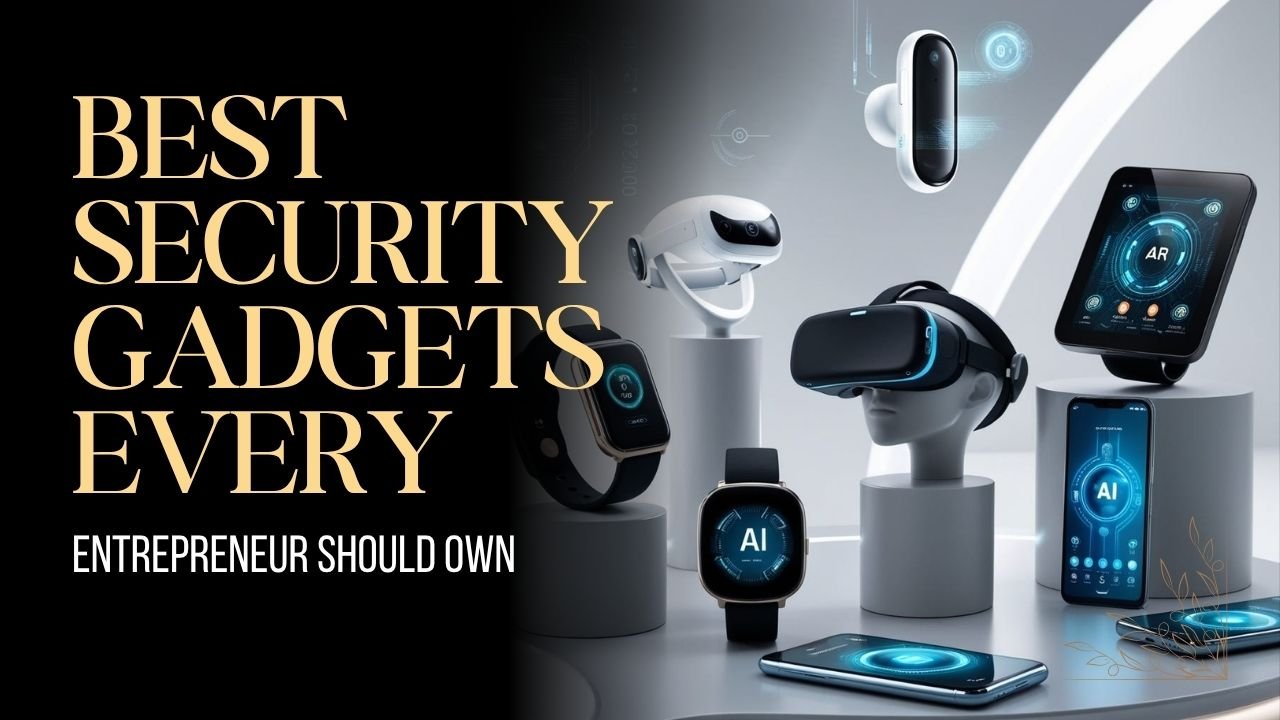Modern businesses don’t just run on hustle—they run on trust: customers trust you with their data, teams trust you with their safety, and investors trust you with resilience.
The smartest way to honor that trust is a future-ready security stack that blends strong identity, always-on connectivity, smart detection, and clean access control.
This 1200-word guide lays out the best security gadgets every entrepreneur should own in 2026, how to prioritize them, and exactly what specs to look for—no fluff, no jargon.
Why You Need a Future-Ready Security Stack
Hybrid work, cloud software, and connected devices have multiplied risk points. That’s not a reason to panic; it’s a prompt to standardize and simplify. Your security gadgets should be:
- Proactive: deter and detect before harm.
- Resilient: continue working during internet or power outages.
- Easy to manage: clear admin controls, role-based access, and actionable alerts.
- Scalable: make sense for a team of 3 and a team of 300.
In short: less noise, more signal—and a layered approach that never depends on a single device to save the day.
The Core Kit (What to Buy and Why)
1) Hardware Security Keys (FIDO2/Passkeys)
If you only implement one thing this quarter, make it phishing-resistant authentication. Hardware security keys stop most account takeovers cold by requiring a physical tap or presence for sign-in. Deploy them on email, payroll, banking, CRM, cloud storage, and admin consoles.
What to look for: FIDO2 support, USB-C/NFC options, admin recovery workflows, and per-role provisioning. Keep two sealed spares per admin role in a secure safe.
Why it matters: Stolen credentials remain the fastest path into a business. Keys transform risky logins into strong, low-friction access.
2) LTE/5G Internet Failover Router
Security dies in downtime. When your primary ISP drops, your cameras, alarms, access control, POS, and 2FA prompts must keep working. A dual-WAN router with automatic cellular failover flips you to LTE/5G within seconds and flips back automatically.
What to look for: Instant failover, carrier-flexible SIMs, cloud management, and traffic shaping (so alarms and cameras stay prioritized).
Why it matters: Outages happen; resilient connectivity makes them a minor event, not a costly crisis.
3) Business-Grade Smart Cameras with AI Analytics
Consumer cameras are fine for living rooms. Your business needs AI-assisted detection (people/vehicle), privacy zones, tamper alerts, and role-based access with audit logs. Prefer PoE (Power over Ethernet) for reliability and consistent power.
What to look for: Encrypted video, custom alert zones, exportable evidence clips, multi-site dashboards, and granular user permissions.
Why it matters: Fewer false alerts, better evidence, and clean sharing with authorities or insurers.
4) Professionally Monitored Alarm Hub
A pro-monitored alarm hub connects door/window sensors, glass-break, panic buttons, and environmental sensors (smoke, water) to a 24/7 dispatch center. With cellular and battery backup, it works even when power and fiber don’t.
What to look for: Commercial-grade plans, fast dispatch SLAs, multiple user PINs, contract flexibility, and remote arming/disarming.
Why it matters: DIY alerts are easy to miss. Professional monitoring adds accountability and a human response when it counts.
5) Shielded Motion-Sensor Lighting
Good lighting is both a deterrent and a camera assistant. Choose full-cutoff (downward) fixtures with PIR motion sensors, dusk-to-dawn schedules, and battery backup. Place them at entries, loading bays, and car parks.
What to look for: Adjustable sensitivity, linked lighting scenes, and weather-rated housings.
Why it matters: You get visibility on demand without glare that obscures faces or triggers constant false alarms.
6) Smart Access Control (Mobile, PIN, or Badge)
Replace chaotic key handoffs with cloud access control. Issue time-bound mobile passes, temporary PINs, or badges to staff and contractors. Revoke instantly, see logs in real time, and group permissions by role.
What to look for: Door and schedule policies, visitor links, directory/SSO integration, and offline capability for network hiccups.
Why it matters: Keys get copied and lost. Digital access is controlled, auditable, and painless to scale.
7) Zero-Trust Remote Access (ZTNA/SASE)
Traditional VPNs are all-or-nothing. Zero-trust grants per-app access based on user + device health. That slashes lateral movement and tightens compliance.
What to look for: Device posture checks, per-app tunnels, SSO integration, DNS filtering, and central policy with audit trails.
Why it matters: Remote and contractor access becomes precise, trackable, and easily revocable—without network sprawl.
8) Encrypted Backups & Ransomware-Resilient NAS
Assume a day will come when you must restore—fast. Pair immutable/cloud backups with a NAS that supports snapshot rollback. Keep at least one offline copy and run quarterly restore drills.
What to look for: Versioned snapshots, encryption at rest and in transit, backup verification, and clearly documented recovery steps.
Why it matters: No security is perfect. Tested recovery turns a worst-day breach into a manageable cleanup.
Quick Comparison (Specs You Actually Need)
| Gadget/Control | Primary Benefit | Key Specs/Features | Ideal Use Cases |
|---|---|---|---|
| Hardware Security Keys | Block account takeovers | FIDO2, USB-C/NFC, admin recovery, per-role keys | Founders, finance, IT admins |
| LTE/5G Failover Router | Keep security online during ISP outages | Dual-WAN, instant failover, SIM flexibility, cloud management | Retail, clinics, offices |
| AI Smart Cameras (PoE) | Accurate alerts + strong evidence | Encrypted video, smart zones, tamper alerts, RBAC, audit logs | Warehouses, storefronts |
| Pro-Monitored Alarm Hub | 24/7 dispatch you can trust | Cellular + battery backup, panic buttons, flexible contracts | Any physical premises |
| Motion-Sensor Lighting | Deterrence + visibility | Full-cutoff, PIR motion, dusk-to-dawn, backup power | Entrances, lots, loading bays |
| Cloud Access Control | Keyless, revocable entry | Mobile/PIN/badge, time rules, real-time logs, offline mode | Offices, storerooms |
| ZTNA/SASE | Safer remote work, less lateral movement | Per-app access, device posture, SSO, logging | Hybrid/contractor teams |
| Encrypted Backups/NAS | Fast, clean recovery | Immutable snapshots, offline copy, tested restores | All critical data |
Deployment Playbook (Do It In This Order)
- Secure identities first. Roll out hardware security keys and passkeys for core apps; enforce role-based access everywhere and disable legacy factors where possible.
- Ensure connectivity resilience. Add LTE/5G failover so cameras, alarms, and access control never go dark. Test failover quarterly with a simple checklist.
- Layer detection and response. Install a pro-monitored alarm hub and AI-capable cameras, then fine-tune alerts (people/vehicle zones) to reduce noise.
- Harden the perimeter. Use shielded motion lighting at doors and driveways. Confirm camera fields of view overlap critical pathways.
- Tidy up remote access. Replace broad VPNs with ZTNA/SASE so contractors and staff get access only to what they need.
- Guarantee recovery. Configure immutable backups, keep an offline copy, and schedule quarterly restore drills (not just backup checks).
Pro Tips that Save Money (and Headaches)
- Standardize vendors: One ecosystem each for cameras, access control, and keys cuts training time and support tickets.
- Separate admin identities: Keep privileged accounts separate from daily email/chat. Enforce just-in-time elevation for sensitive tasks.
- Label everything: Name cameras by location (e.g., “North Entry – Inside”), label breakers, and keep a one-page incident checklist near the alarm panel.
- Measure what matters: Track MTTD (mean time to detect), false-alert rate, and restore time. If those numbers improve, your stack is working.
Security isn’t a single gadget; it’s a layered system that protects what you’re building from multiple angles. The winning formula for 2026 and beyond is simple:
- Strong identity with hardware security keys,
- Resilient connectivity via LTE/5G failover,
- Smart detection and response through pro-monitored alarms and AI cameras,
- Clean access control (cloud badges/PINs + ZTNA), and
- Proven recovery with encrypted, immutable backups you actually test.
Deploy these future-ready security gadgets, and you’ll reduce risk, speed up response, and keep customers, teams, and partners confident that your business is built on solid ground.
FAQs
If my budget is tight, what’s the exact buy order?
Start with hardware security keys (identity first), then LTE/5G failover (so security survives outages), then a pro-monitored alarm hub and AI cameras. Add cloud access control and ZTNA as your headcount and app list grow.
How many hardware keys do I need?
Plan two keys per critical user (primary + backup) and two sealed spares per admin role stored securely. This ensures recovery if a key is lost.
Do I still need a VPN if I adopt zero-trust?
You can keep a minimal VPN for legacy systems, but zero-trust (ZTNA) is safer and easier to audit. It grants per-app access, checks device health, and cuts lateral movement.




